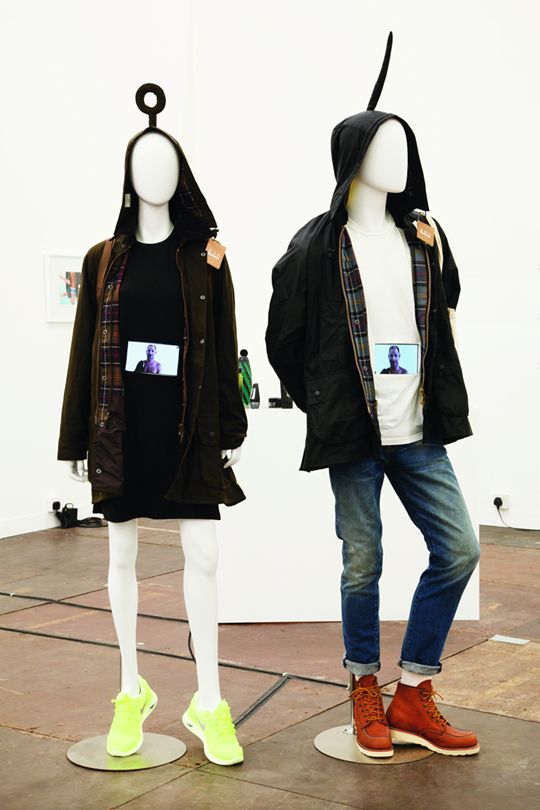UTILITY FASHION
| August 3, 2015 | Post In 2015年6月号

Courtesy the artist
Streetwear marketing campaigns, speaking to the desire to glamorize everyday urban realities, can index subterranean social preoccupations in a way parallel to yet often more eloquent than contemporary art. See the role of Adidas sportswear in the iconography of the post-Soviet Russian mafia, for example, or Nike’s Air Jordan line, present in so much of the best rap music of the 1990s. The trendiest trends of the past few years attempt to cope with the condition of the alienated urban citizen in a world experiencing collapse of all kinds: health goth, with its fetishized body, recuperation of corporate logos, and sterile vibe of paranoia; normcore, with its attempt to subvert the logic of mass production, addressing nostalgia for a mass middle-class society organized along similar experiences shared collectively via the technique of the readymade (in fact, the practice of thrifting presaged normcore by quite some time, albeit without bringing the idea of generic to quite the same level). And yet, if health goth’s austere logic of total self-control alludes to the individual’s relationship with himself and his body, streetwear today engages with the outside world—perilous, dirty, and exciting.
Conspicuous consumption among men is always seen as slightly naff; it’s necessary to justify the object of desire as being of practical value. Even if the Range Rovers cruising central London will never need to engage in four-wheel drive, at least their owners are secure in the knowledge that they could if they needed to. As rural aesthetics come to western cities subconsciously grappling with the idea that the climate is changing, outdoor brands like Barbour jackets or Sperry shoes, designed with bucolic pursuits in mind, hit the streets.

Josh Kline, Get the Look: 2011, 2012, modified fiberglass mannequin, Barbour jacket, topshop t-shirt, dress, Fjallraven Kanken backpack, Nike running shoes, screen, media player, speakers, power strip, USB stick, video file, 180.3 x 83.8 x 60.9 cm
RIGHT:
Josh Kline, Get the Look: 2009, 2012, modified fiberglass mannequin, Barbour jacket, Levi’s jeans, t-shirt, tote-bag, Redwing boots, screen, media player, speakers, power strip, USB stick, video file, 180.3 x 83.8 x 60.9 cm
Courtesy 47 Canal, New York
PHOTO: Isabel Asha Penzlien
We don’t worry about these things anymore. With smog in Beijing and Paris, ultra-cold winters in New York, and drought in Los Angeles, the city itself feels less the insulated safe space it once was and more an ecosystem of its own; the urban is the new nature. Utility gear that combines urban chic—blacks and grays, slim fits—with the need to cope with unpredictable conditions repackages the environmental apocalypse as an opportunity for peacocking.
While there have been countless interventions by fresh fashion school graduates, as well as reinventions of boutique lines like Blaak, Vejas, and Sons of William, Nike’s reintroduction of its ACG line may be the most compelling recent intervention pushing this dialogue forward. For Nike, “the ultimate terrain is the city,” as it is for so many of us. Yet instead of the ruins seen by Gustave Doré’s New Zealander, cyberpunk heroes, or anyone looking out the window at the Fourth Ring Road, the City of Light makes a return for the ACG man: crouched on a parapet, he surveys a city ripe with possibility and opportunity through which he hunts and frolics. All conditions gear is a corporate and democratic response to climate change; we don’t care enough to stop—what do we need to do to keep going?

